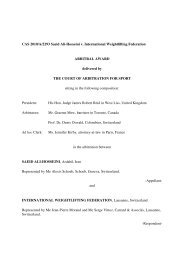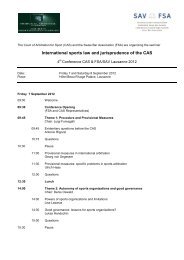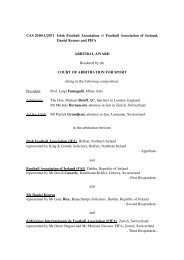(CAS) Bulletin - Tribunal Arbitral du Sport / TAS
(CAS) Bulletin - Tribunal Arbitral du Sport / TAS
(CAS) Bulletin - Tribunal Arbitral du Sport / TAS
You also want an ePaper? Increase the reach of your titles
YUMPU automatically turns print PDFs into web optimized ePapers that Google loves.
Article 293 UCI ADR determines the consequence<br />
of an anti-doping rule violation:<br />
“ The period of Ineligibility imposed for a fi rst anti-doping rule<br />
violation under article 21.1 (Presence of a Prohibited Substance<br />
or its Metabolites or Markers), article 21.2 (Use or Attempted<br />
Use of a Prohibited Substance or Prohibited Method) or article<br />
21.6 (Possession of a Prohibited Substance or Prohibited<br />
Method) shall be<br />
2 (two) years’ Ineligibility<br />
unless the conditions for eliminating or re<strong>du</strong>cing the period of<br />
Ineligibility as provided in articles 295 to 304 or the conditions<br />
for increasing the period of Ineligibility as provided in article<br />
305 are met ”.<br />
The Athlete seeks to eliminate or re<strong>du</strong>ce the 2-year<br />
period of ineligibility based on Articles 296 and 297<br />
UCI ADR. These Articles provide the following:<br />
Article 296 UCI ADR:<br />
“ If the Rider establishes in an indivi<strong>du</strong>al case that he bears<br />
No Fault or Negligence, the otherwise applicable period of<br />
Ineligibility shall be eliminated. When a Prohibited Substance<br />
or its Markers or Metabolites is detected in a Rider’s Sample as<br />
referred to in article 21.1 (presence of a Prohibited Substance),<br />
the Rider must also establish how the Prohibited Substance<br />
entered his system in order to have the period of Ineligibility<br />
eliminated. In the event this article is applied and the period of<br />
Ineligibility otherwise applicable is eliminated, the anti-doping<br />
rule violation shall not be considered a violation for the limited<br />
purpose of determining the period of Ineligibility for multiple<br />
violations under articles 306 to 312 ”.<br />
Article 297 UCI ADR:<br />
“If a License-Holder establishes in an indivi<strong>du</strong>al case that<br />
he bears No Signifi cant Fault or Negligence, then the period<br />
of Ineligibility may be re<strong>du</strong>ced, but the re<strong>du</strong>ced period of<br />
Ineligibility may not be less than one-half of the period of<br />
Ineligibility otherwise applicable. If the otherwise applicable<br />
period of Ineligibility is a lifetime, the re<strong>du</strong>ced period under this<br />
section may be no less than 8 (eight) years. When a Prohibited<br />
Substance or its Markers or Metabolites is detected in a Rider’s<br />
Sample as referred to in article 21.1 (presence of Prohibited<br />
Substance), the Rider must also establish how the Prohibited<br />
Substance entered his system in order to have the period of<br />
Ineligibility re<strong>du</strong>ced”.<br />
The strict liability principle of the above-quoted<br />
Article 21.1.1 UCI ADR is applicable to the present<br />
dispute. The contention that the prohibited substance<br />
did not have a performance enhancing effect on the<br />
Athlete and that he must have ingested the substance<br />
inadvertently does not preclude the application of the<br />
strict liability principle.<br />
Consequently, pursuant to Articles 22, 296 and<br />
297 UCI ADR and according to established <strong>CAS</strong><br />
jurisprudence (<strong>CAS</strong> 2005/A/922, 923 & 926, <strong>CAS</strong><br />
2006/A/1067, <strong>CAS</strong> 2006/A/1130), in order for the<br />
athlete to escape a sanction, the burden of proof<br />
shifts to the athlete who has to establish;<br />
1) how the prohibited substance entered the<br />
athlete’s system; and<br />
2) that the athlete in an indivi<strong>du</strong>al case bears no<br />
fault or negligence, or no signifi cant fault or<br />
negligence.<br />
Pursuant to Art. 22 UCI ADR, and as it is for the<br />
athlete to establish the above mentioned facts:<br />
“ Where these Anti-Doping Rules place the burden of proof<br />
upon the License-Holder alleged to have committed an antidoping<br />
rule violation to rebut a presumption or establish<br />
specifi ed facts or circumstances, the standard of proof shall be<br />
by a balance of probability,…”<br />
2. The issues that need to be decided<br />
As already explained, the results of the tests and<br />
the presence of the Prohibited Substance in Mr<br />
Contador’s body were not contested. Therefore,<br />
pursuant to the regulatory framework as descried<br />
above and the submission of the parties, the main<br />
questions to be resolved by the Panel in the present<br />
dispute are:<br />
- Taking into account that an anti-doping rule<br />
violation has been established by the Appellants,<br />
did Mr Contador establish, considering the<br />
required standard of proof, how the prohibited<br />
substance entered his system?<br />
- If Mr Contador is able to convince the Panel with<br />
the required standard of proof how the prohibited<br />
substance entered his system, does he, in such<br />
circumstances, bear no fault or negligence or no<br />
signifi cant fault or negligence?<br />
- If necessary, what must be the sanction imposed<br />
on Mr Contador? Particularly, how long shall<br />
the period of ineligibility last, when would such<br />
period commence and which results would have<br />
to be disqualifi ed, leading to loss of prize money<br />
and ranking points?<br />
3. The aplication of the burden and standard of<br />
proof in the circumstances of this case<br />
As previously explained, in this case Mr Contador<br />
alleges that the Prohibited Substance entered his<br />
Jurisprudence majeure / Leading cases<br />
-<br />
110





